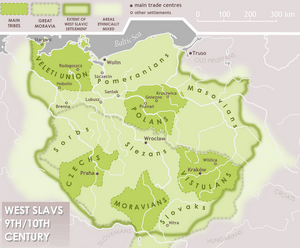History of Poland in the Middle Ages facts for kids
This article explores the exciting history of Poland during the Middle Ages. This long period lasted for about a thousand years, from the 5th century to the 16th century. It began after the Fall of the Western Roman Empire and ended before the Early Modern Period. The Middle Ages saw the rise of new ideas like humanism and the Reformation. These changes helped shape Europe into what it is today.
Early Polish History
The first groups of Slavic people arrived in what is now southeastern Poland. They settled near the Vistula River and in southern Masovia. These groups came from areas around the Dnieper River. Scientists believe the earliest home of the Slavs was in the middle Dnieper basin.
The West Slavs were a main branch of these early Slavic people. They moved into Poland in the second half of the 5th century. This was about 50 years after Germanic tribes had left these lands. Many experts now think Slavic tribes were not in Poland before this time.
From the 6th century, these new people spread north and west. They mostly grew crops to live. They also hunted and gathered food. Their travels happened while other groups like the Huns, Avars, and Magyars were moving into Eastern and Central Europe.
A number of West Slavic Polish tribes started small states around the 8th century. Some of these states later joined together to form bigger ones. The Vistulans lived in southern Poland, with Kraków as a main city. But the Polans tribe, meaning "people of the fields," became very important. They settled in the plains around Gniezno. This area became the early center of Poland.
These tribal states built many gords. Gords were strong forts with earth and wood walls. They were built from the 7th century onwards. Some gords were busy towns. Others were empty spaces used as safe places during danger. The Polans started building many gords and expanding their land in the early 10th century. The Polish state grew from their tribal areas in the late 10th century.
The Rise of the Kingdom
The Polish state truly began with Mieszko I. He was a ruler from the Piast dynasty in the late 10th century. Mieszko made a big decision to be baptized as a Christian in 966. After this, Poland became a Christian nation.
Mieszko's son, Bolesław I Chrobry, continued his father's work. He set up a Polish Church region. Bolesław also gained more land and was officially crowned king. He became the first King of Poland.
Later, the kingdom faced some challenges. There was a period when the monarchy almost collapsed. But it was restored by Casimir I. His son, Bolesław II the Bold, had problems with the Church and was forced to leave the country.
After Bolesław III divided the country among his sons, Poland became split. This made the Piast monarchy weaker in the 12th and 13th centuries. One of the regional dukes, Konrad I, invited the Teutonic Knights to help fight the Prussian pagans. This led to many centuries of wars between Poland and the Knights.
The kingdom was brought back together by Władysław I the Elbow-high. His son, Casimir III the Great, made Poland even stronger and larger. However, the western areas of Silesia and Pomerania were lost during the earlier fragmentation. Poland then began to expand more to the east. The strong kingdom built in the 14th century set the stage for a powerful new Poland.
Late Middle Ages and New Unions
A new era began with Jogaila, the Grand Duke of Lithuania. He became King Władysław II Jagiełło of Poland. This started the Jagiellon dynasty (1385–1569). This partnership created the Polish–Lithuanian union.
This union brought huge areas controlled by Lithuania into Poland's influence. It was good for both Poles and Lithuanians. They worked together in one of Europe's largest political groups for 400 years.
In the Baltic Sea region, Poland kept fighting the Teutonic Knights. A major event was the Peace of Thorn under King Casimir IV Jagiellon. This treaty led to the creation of the future Duchy of Prussia. In the south, Poland faced the Ottoman Empire and the Crimean Tatars. In the east, Poland helped Lithuania fight the Grand Duchy of Moscow.
Poland was becoming a feudal state. This meant its economy was mostly based on farming. A group of wealthy landowners, called the landed nobility, became very powerful.
In 1505, the Polish parliament passed the Nihil novi act. This law gave most of the power to make laws to the parliament, not the king. This started a time called "Golden Liberty." During this period, the country was ruled by the "free and equal" Polish nobility.
The Protestant Reformation brought new Christian ideas to Poland. This led to something special for that time in Europe: religious tolerance. People of different faiths could live together peacefully. The European Renaissance also brought a huge flowering of culture in Poland. This happened during the reigns of kings Sigismund I the Old and Sigismund II Augustus. Poland and Lithuania also expanded their land to include the northern region of Livonia.
See also
- Culture of medieval Poland
- Obotrites
- Principality of Nitra


